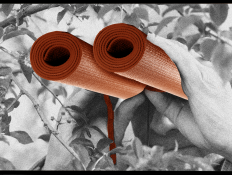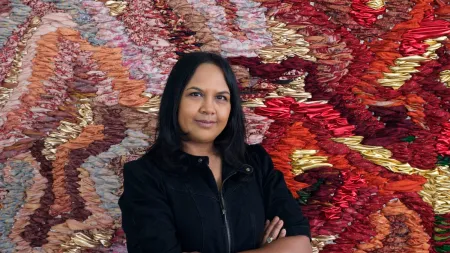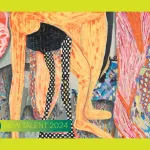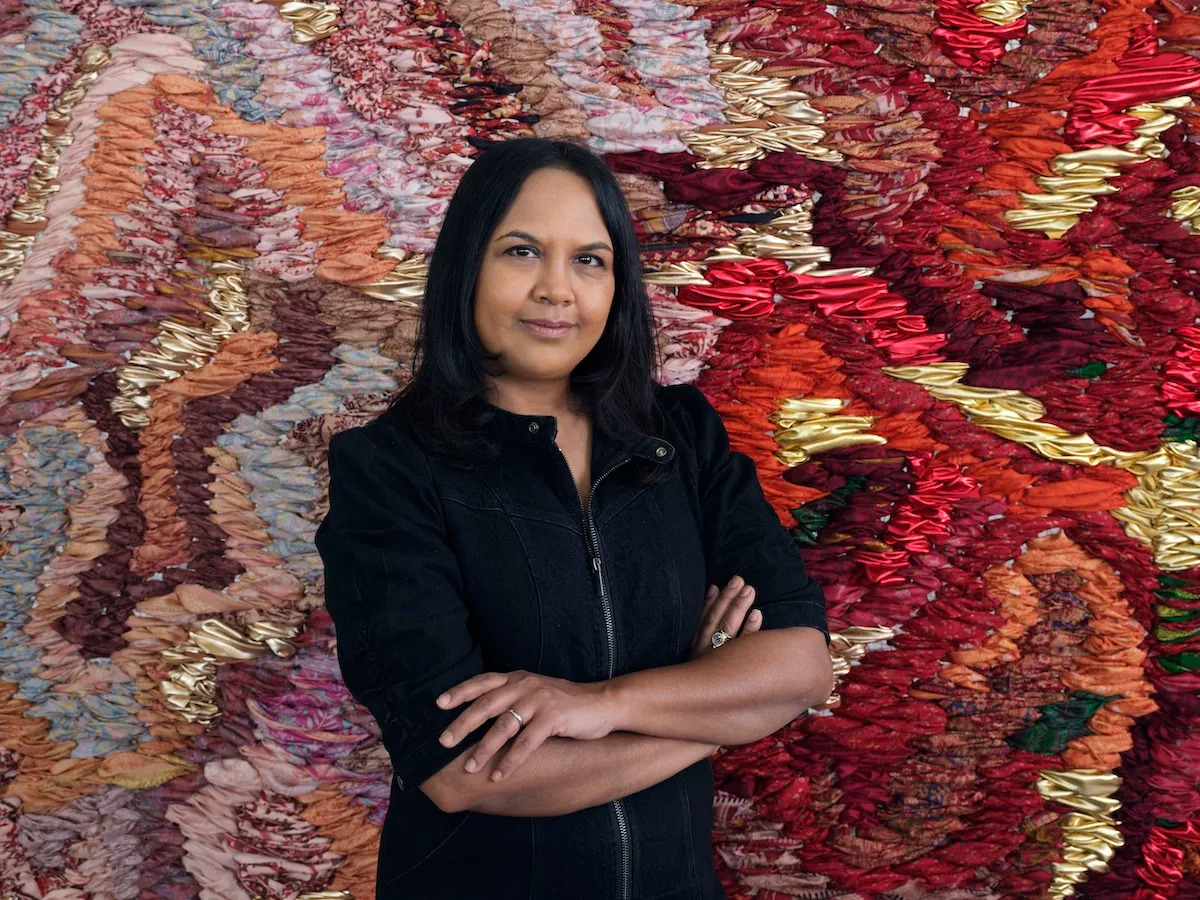
While she was still a high school student in Metuchen, New Jersey, Suchitra Mattai found herself puzzled by a history class she was taking. The course was called World History, but despite its name, it was clearly about the West, not the entire globe. Years later, she realized she had encountered an “obviously absurd gap” in the course’s curriculum.
Born in Guyana to parents of Indian heritage, Mattai faced a similar situation during the years prior, when her family lived in Canada. The teachers mostly taught European and American history, with occasional units on Asia and Africa. However, her family exposed her to the folktales and histories of India, where her great-grandparents were born. She determined that she would fill in the gaps of the histories she was taught in school.
Mattai, 51, has since continued that project with her art, in which richly colored vintage saris, fabric, embroidery floss, vintage needlepoints, beads, videos, and found objects like jewelry combine in works exploring gender, labor, migration, colonialism, and what it means to belong to a community.
The artist “is building upon techniques and traditions that have existed for many centuries but at the same time she is very much forging her own path,” Hannah Shambroom, assistant curator at the National Museum of Women in the Arts in Washington, D.C., told ARTnews. “She is coming up with her own techniques in terms of how she’s weaving these very large-scale tapestries, and then she’s using materials that come from other decades and generations.”
“I feel strongly that looking at oral histories and material history is the most effective way to tell those stories,” Mattai said. She added that the saris she uses “already have these people’s bodies written into them, [connecting their] stories and smells.”
Siren Song (2022), a work in Mattai’s current survey at the National Museum of Women in the Arts, is an installation composed of vintage saris and fabric; on the ceiling is a projection of the Atlantic Ocean filmed by the artist. The tapestries hang down from above, creating a womb-like interior that can be entered. The piece reflects the journey of Mattai’s ancestors, who migrated from India to Guyana as indentured laborers in the 19th century to work on sugar plantations following the end of slavery during British colonial rule.
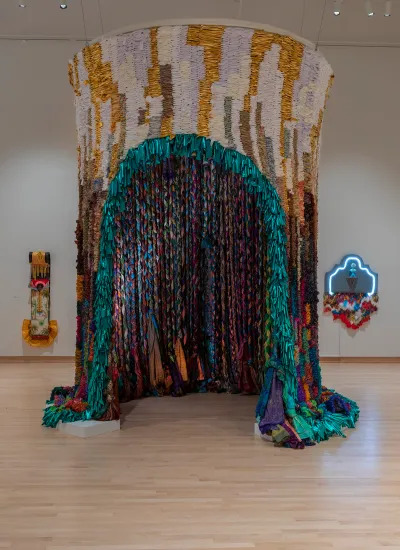
“I was able to cross, strangely on a ship, kind of following my ancestors’ footsteps. I crossed all the way from India to Brazil and that path is the [one I believe] my ancestors would have been taken,” Mattai recalled. “And I remember on that voyage just being so struck by the vast water, by the unknown but also being more and more distant from the past. I could feel an energy there that was really quite overwhelming.”
Her D.C. show—one of four US institutional shows by Mattai to open in the past six months—features 40 of her large-scale textile installations and mixed-media works, and pairs these pieces with art by others who hail from South Asia and Europe made between the 18th and 20th centuries. The artist said the idea is to contextualize her art—and to create new histories, placing Indian miniature paintings within the same galleries as sculptures by Louise Bourgeois. The show is her way of “undoing what we know [and] setting up a space where these connections that are not usually made can be made.”
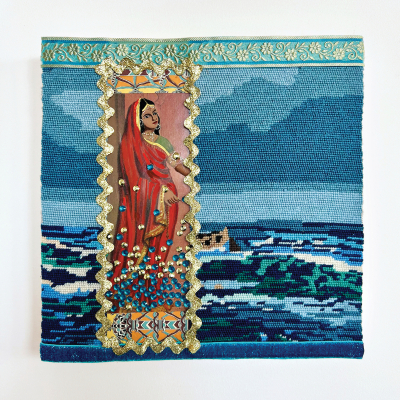
Born in Guyana in 1973, Mattai and her family emigrated from the South American country when she was three and a half years old. Her family moved abroad so her father could attend graduate school, first to Wolfville, Nova Scotia, then to Halifax, in Canada. The family later immigrated to the United States when Mattai was 10.
In her late teens, she started researching Indian art because she “wanted to connect to her past.” Mattai knew she always wanted to be an artist, but as the child of immigrants, a career in the arts wasn’t considered a viable option. Because she first had to satisfy her family’s wishes, it took her “a while” to become an artist. To fulfil that wish, she attended Rutgers University in New Jersey as an undergraduate, majoring in statistics. She studied art, but never completed the courses needed to declare art as her major.
“I knew I wasn’t going to use the statistics [degree]. It was a matter of fear. To be an artist takes a lot of courage,” Mattai said. “And I didn’t have role models who were artists. When I was in my 20s, I didn’t see people of color in museums and galleries, so it didn’t feel like something I could partake in as a profession.”
She forged onward, pursuing a PhD in South Asian studies, with a focus on South Asian contemporary art, at the University of Pennsylvania because she thought it would allow her to write about ideas in the field, and because “academia makes space for other voices as well,” she said. After her third year, she realized she was “in the wrong place” and decided to leave the program to “pursue my life-long love” to be a practicing artist. (Still, she completed the requirements to receive a MA degree.)
That marked the beginning of her career as an artist, mainly as a painter. Her initial attempts at incorporating embroidery into her work weren’t well received. That led to what she called “a long sort of hiatus” in her practice—and, later on, a “rebirth” eight years ago. The latter came from a decision to do away with Western traditions and follow her “intuition in the way that my family would operate.” The artist started using the sewing, weaving, embroidering, and other textile techniques she learned from her grandmothers. At the time, she was living in Denver. Being in that Colorado city, outside the art centers of New York and Los Angeles, was an advantage, she said, because it afforded her the freedom to explore and experiment without the pressure to conform to what was in style.
During that period, Mattai started embroidering and crocheting pieces intended to celebrate the resilience of women and the roles they play in the domestic sphere, which are often overlooked. She thought of her illiterate grandmother, who worked in rice paddies and was married at 14, and decided to tell stories about her ancestral homeland using found objects and saris previously worn by women in India and its diaspora.
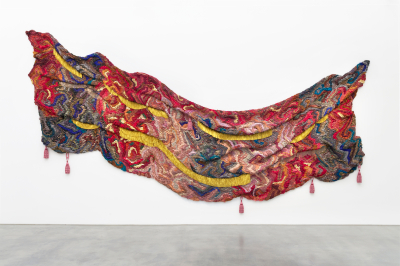
In 2018, Mattai participated in the Sharjah Biennial in the United Arab Emirates, which commissioned her to create her largest installation to date. The work included large-scale sari tapestries, a video of border walls, and a spinning vintage merry-go-round.
She has continued to work at a large scale, producing works such as 2024’s she arose (from a pool of tears), which features in her D.C. exhibition. The sculpture is inspired by her family members who danced, including two of her sisters. (Mattai said she also studied classical dance, but “was just terrible” at it.) Using braided saris, the artist sculpted a life-size dancer based on Bharatanatyam, a classical Indian dance form. The dancer is in “between poses, moving from one pose steeped in tradition to one of her own creation,” Mattai said. “It’s actually a new direction for me in terms of figurative sculpture, which I haven’t done before.”
Also included in the show is the site-specific work, a yakshi trance II, 2024, which features a plaster and salt casts of antique Indian yakshis, or figures associated with fertility and prosperity. Mattai has wrapped her yakshis around the columns in the museum’s galleries.
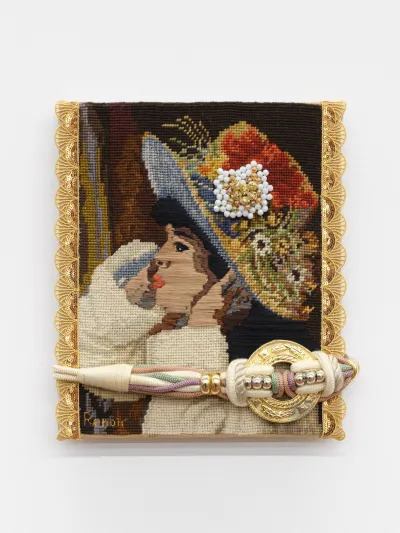
These works figure alongside objects such as the 1856 book The Grammar of Ornament by British architect and designer Owen Jones. The book contains language about the non-Western world including classifying some ornaments from Africa as belonging to “savage tribes” that the artist described as “not very surprising but very disconcerting.” Here, Mattai uses pages from the book as collage materials in pieces including safe space, 2021, the garden, 2022 and a woman we never knew but loved all the same, 2024 to share different narratives and stories. “Deconstructing and reworking the pages is a post-colonial act,” she explained.
The artist is “re-envisioning how we see the world [and] whose histories are told,” said Shambroom, who curated Mattai’s “Myth from Matter” at the National Museum of Women in the Arts, adding that the artist is “creating these new stories, new histories and this alternate way of seeing.”
Mattai said: “It’s the main aspect of my practice to share these stories and to explore the different ways that one can do so.”
Paige Beeber’s Dizzying, Layered Abstractions
Sotheby’s Will Auction Hundreds of Works from Aso O. Tavitian’s Collection

Inside Time and Tide, the New N.Y.C. Seafood Restaurant That Honors Late Chef James Kent

Hugo Boss Delays Mid-Term Goals After Sluggish Q3

iOS 18.2 beta features: Everything new coming to your iPhone

Industry Convenes at Nasdaq for Sportico’s ‘Invest in Sports’
